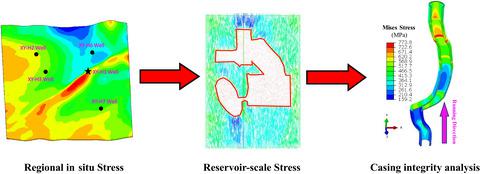当前位置:
X-MOL 学术
›
Energy Sci. Eng.
›
论文详情
Our official English website, www.x-mol.net, welcomes your
feedback! (Note: you will need to create a separate account there.)
On how asymmetric stimulated rock volume in shales may impact casing integrity
Energy Science & Engineering ( IF 3.5 ) Pub Date : 2020-01-14 , DOI: 10.1002/ese3.610 Hao Yu 1 , Arash Dahi Taleghani 2 , Zhanghua Lian 1 , Tiejun Lin 1
Energy Science & Engineering ( IF 3.5 ) Pub Date : 2020-01-14 , DOI: 10.1002/ese3.610 Hao Yu 1 , Arash Dahi Taleghani 2 , Zhanghua Lian 1 , Tiejun Lin 1
Affiliation

|
Microseismic data and production logs in our study area have confirmed asymmetric developments of the stimulation rock volume in shales with respect to the wellbore, while severe casing deformation problems have been reported frequently in this area. Here, we propose a systematic methodology to investigate the possibility of casing failure due to strong shear stresses induced by asymmetric stimulated zones. A mechanical earth modeling (MEM) is initially performed to determine the in situ stress field in the target layer before fracturing by incorporating the existing geological features, logging data, and rock anisotropy. Then, we provide a computationally cheap and efficient estimation for stimulated rock volume of each stage by considering the possible overlaps in adjacent stages based on the clustered microseismic clouds. Using this approach, a reservoir‐scale 3D coupled model tied to a more detailed near‐wellbore part incorporating the casing string and the cement sheath is established to simulate the development of stimulation zones, stress redistribution, and their impacts on casing deformation as each stage fracturing treatment chronologically goes on. Our numerical results indicate that continuous redistribution and re‐orientation of stress field near the borehole are tracked during pumping the treatment which reveals formation of some pockets of tensile stresses along and around the wellbore. Asymmetric stimulations are observed to generate strong shear stress on the suspended casing. These shear forces result in deflection and S‐shape deformations accompanied with cross‐sectional ovality. Some regions receive repeating treatments, which results in intensifying formation stress heterogeneity and worsen casing deformation severity. The calculation results are compared with measurement of multi‐finger imaging tool (MIT) to validate the accuracy. Our analysis has indicated that simply increasing the flexural strength by increasing thickness of casing cannot radically mitigate casing deformation problems. This paper presents a novel workflow for a coupled modeling of casing deformation during hydraulic fracturing operations, while current modeling efforts assume symmetric bi‐wing fracture geometries.
中文翻译:

页岩中非对称受激岩石体积如何影响套管完整性
我们研究区的微地震数据和生产测井资料证实,相对于井眼而言,页岩中的增产岩石体积是不对称的,而在该地区,经常出现严重的套管变形问题。在这里,我们提出了一种系统的方法来研究由于不对称受激区域引起的强剪切应力而导致套管破裂的可能性。首先,通过合并现有的地质特征,测井数据和岩石各向异性,进行机械地球建模(MEM),以确定压裂之前目标层中的原位应力场。然后,我们基于聚类微地震云,通过考虑相邻阶段中可能存在的重叠,为每个阶段的受激岩体体积提供了计算上便宜且有效的估计。使用这种方法,建立了与更详细的近井部分结合的储层规模的3D耦合模型,该部分结合了套管柱和水泥护套,以模拟随着每个阶段压裂处理的进行,增产区的发展,应力的重新分布及其对套管变形的影响上。我们的数值结果表明,在泵送处理过程中,跟踪了井眼附近应力场的连续重新分布和重新定向,这揭示了沿井眼和井眼周围形成了一些拉应力袋。观察到不对称的刺激会在悬挂的套管上产生强烈的剪切应力。这些剪切力导致挠曲和S形变形以及横截面椭圆度。一些地区接受重复治疗,导致地层应力非均质性加剧,套管变形严重性恶化。将计算结果与多指成像工具(MIT)的测量结果进行比较,以验证准确性。我们的分析表明,仅通过增加套管厚度来增加抗弯强度并不能从根本上缓解套管变形问题。本文提出了一种新颖的工作流程,用于水力压裂作业中套管变形的耦合建模,而当前的建模工作假设对称的双翼裂缝几何形状。我们的分析表明,仅通过增加套管厚度来增加抗弯强度并不能从根本上缓解套管变形问题。本文介绍了一种新颖的工作流程,用于水力压裂作业中套管变形的耦合建模,而目前的建模工作则假设对称的双翼裂缝几何形状。我们的分析表明,仅通过增加套管厚度来增加抗弯强度并不能从根本上缓解套管变形问题。本文提出了一种新颖的工作流程,用于水力压裂作业中套管变形的耦合建模,而当前的建模工作假设对称的双翼裂缝几何形状。
更新日期:2020-01-14
中文翻译:

页岩中非对称受激岩石体积如何影响套管完整性
我们研究区的微地震数据和生产测井资料证实,相对于井眼而言,页岩中的增产岩石体积是不对称的,而在该地区,经常出现严重的套管变形问题。在这里,我们提出了一种系统的方法来研究由于不对称受激区域引起的强剪切应力而导致套管破裂的可能性。首先,通过合并现有的地质特征,测井数据和岩石各向异性,进行机械地球建模(MEM),以确定压裂之前目标层中的原位应力场。然后,我们基于聚类微地震云,通过考虑相邻阶段中可能存在的重叠,为每个阶段的受激岩体体积提供了计算上便宜且有效的估计。使用这种方法,建立了与更详细的近井部分结合的储层规模的3D耦合模型,该部分结合了套管柱和水泥护套,以模拟随着每个阶段压裂处理的进行,增产区的发展,应力的重新分布及其对套管变形的影响上。我们的数值结果表明,在泵送处理过程中,跟踪了井眼附近应力场的连续重新分布和重新定向,这揭示了沿井眼和井眼周围形成了一些拉应力袋。观察到不对称的刺激会在悬挂的套管上产生强烈的剪切应力。这些剪切力导致挠曲和S形变形以及横截面椭圆度。一些地区接受重复治疗,导致地层应力非均质性加剧,套管变形严重性恶化。将计算结果与多指成像工具(MIT)的测量结果进行比较,以验证准确性。我们的分析表明,仅通过增加套管厚度来增加抗弯强度并不能从根本上缓解套管变形问题。本文提出了一种新颖的工作流程,用于水力压裂作业中套管变形的耦合建模,而当前的建模工作假设对称的双翼裂缝几何形状。我们的分析表明,仅通过增加套管厚度来增加抗弯强度并不能从根本上缓解套管变形问题。本文介绍了一种新颖的工作流程,用于水力压裂作业中套管变形的耦合建模,而目前的建模工作则假设对称的双翼裂缝几何形状。我们的分析表明,仅通过增加套管厚度来增加抗弯强度并不能从根本上缓解套管变形问题。本文提出了一种新颖的工作流程,用于水力压裂作业中套管变形的耦合建模,而当前的建模工作假设对称的双翼裂缝几何形状。











































 京公网安备 11010802027423号
京公网安备 11010802027423号